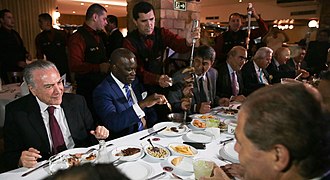Rodízio

Rodízio (pronounced [ʁoˈdʒiziu] in Brazil) is an all-you-can-eat style of restaurant service in Brazilian restaurants.
Description[]

In most areas of the world outside of Brazil, a rodízio restaurant refers to a Brazilian-style steakhouse restaurant. Customers pay a fixed price (preço fixo), and waiters bring samples of food to each customer repeatedly throughout the meal, until the customers signal that they have had enough to eat.[1]
In churrascarias or the traditional Brazilian-style steakhouse restaurants, servers come to the table with knives and a vertically-held skewer, on which are speared various kinds of premium cuts of meat, most commonly local cuts of beef, pork, chicken, lamb, and sometimes atypical or exotic meats.[1] The exact origin of the rodízio style of service is unknown, but the traditional story is that this serving style was created when a waiter delivered a meat skewer to the wrong table by mistake but let the guest take a small piece of the meat anyway.[2] Rodízio became increasingly popular in Brazil in the mid-20th century and spread around the world as experienced servers moved to open their own restaurants.[2] In Brazil, the rodízio style is sometimes also found in Italian or more recently Japanese restaurants.[2] Italian restaurants serving pizza are especially common.
Most rodízio courses are served right off the cooking spit and are sliced or plated right at the table.[1] Thin slices are carved from the roasted outside layer of large cuts; the diners may use a pair of small stainless-steel tongs to grab the slices as they are cut, and then place them on their plate. Alternatively, the server will push smaller kebab-style chunks off the end of the skewer onto a serving plate.
Sometimes, the meat servings are accompanied with fried potatoes, fried bananas, collard greens, black beans, rice, salads, or other side dishes (self-served buffet style).
In many restaurants, the diner is provided with a colored card or token. Green, on one side, indicates to servers to bring more meat. Red, on the other side, indicates that the diners have enough for the moment.[1] This does not necessarily signal that the diner is finished eating, but only indicates that no more meat servings are desired at that moment.
Fare[]
The following foods are often seen at a churrascaria served rodízio style:
- Filet mignon chunks wrapped in bacon
- Turkey chunks wrapped in bacon (these two are usually two-bite sized)
- Sirloin steak (cut semicircular and served in slices)
- Roast beef (served like sirloin steak)
- Rump cover (called picanha in Portuguese)
- Beef short ribs
- Lamb
- Pork ribs
- Chouriço or some other spicy Iberian pork sausage
- Chicken hearts
- Grilled dark-meat chicken
- Grilled pineapple or banana (meant as a palate cleanser between courses)

A rodízio side dish buffet selection

Assortment of raw meats being set up for churrascaria grilling

Brazilian politicians being served rodízio style
See also[]
| Look up rodízio in Wiktionary, the free dictionary. |
- Brazilian cuisine
- Culinary art
References[]
- ^ a b c d Ro, Herrine (2016-08-03). "The complete guide to Brazilian barbecue". Archived from the original on 2018-05-02. Retrieved 2018-05-01.
- ^ a b c Tonon, Rafael (2016-10-06). "'Meat-Eater's Mecca': How the Brazilian Steakhouse Swept America". Archived from the original on 2018-05-02. Retrieved 2018-05-01.
- Restaurants by type
- Food and drink in Brazil


